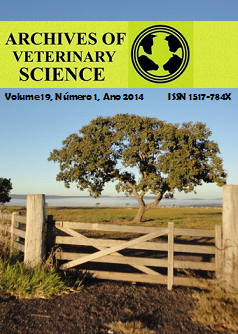COMPARISON AMONG THREE TECHNIQUES IN THE PARASITOLOGICAL DIAGNOSIS OF Fasciola hepatica IN CATTLE
DOI:
https://doi.org/10.5380/avs.v19i1.31372Palavras-chave:
parasitological diagnosis, sedimentation quantitative techniques, trematode, Fasciola hepatica, cattleResumo
Helminthosis are relevant because they are responsible by substantial economic losses. Many techniques have been developed to facilitate parasitological diagnosis and comparisons among these techniques are essential. The present work aimed a comparison among three techniques of quantitative sedimentation for parasitological diagnosis of Fasciola hepatica in cattle. The modified sedimentation techniques of Dennis, Stone & Swanson (DSS), Girão and Ueno (quatro tamises - QT; four sieves) and Foreyt were compared using analysis of variance, linear regression and correlation tests. Evaluations of sensitivity, specificity and agreement were performed using the kappa test. It was found that the modified DSS technique had a high mean egg count and high sensitivity (p<0.01) (48.60%). The three techniques showed a specificity of 100%. There was no correlation among the values of egg count obtained by the three techniques, and significant coefficients were not observed by regression analysis. The egg count results of F. hepatica obtained by the techniques of quatro tamises and Foreyt showed excellent concordance by the kappa test. The modified DSS technique appeared to be the most effective for F. hepatica diagnosis in cattle (p<0.01).
Downloads
Publicado
Como Citar
Edição
Seção
Licença
Autores que publicam nesta revista concordam com os seguintes termos:
- Autores mantém os direitos autorais e concedem à revista o direito de primeira publicação, com o trabalho simultaneamente licenciado sob a Creative Commons - Atribuição 4.0 Internacional que permite o compartilhamento do trabalho com reconhecimento da autoria e publicação inicial nesta revista.
- Autores têm autorização para assumir contratos adicionais separadamente, para distribuição não-exclusiva da versão do trabalho publicada nesta revista (ex.: publicar em repositório institucional ou como capítulo de livro), com reconhecimento de autoria e publicação inicial nesta revista.
- Autores têm permissão e são estimulados a publicar e distribuir seu trabalho online (ex.: em repositórios institucionais ou na sua página pessoal) a qualquer ponto antes ou durante o processo editorial, já que isso pode gerar alterações produtivas, bem como aumentar o impacto e a citação do trabalho publicado.














